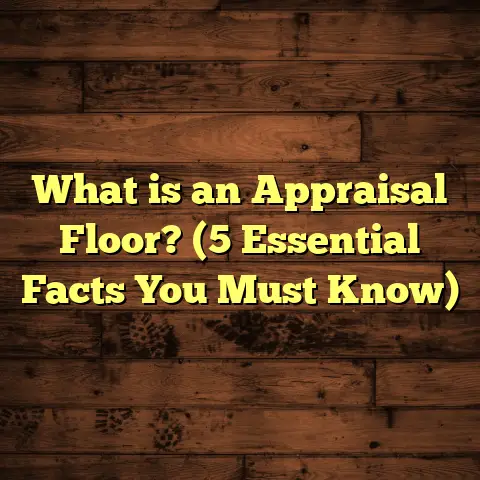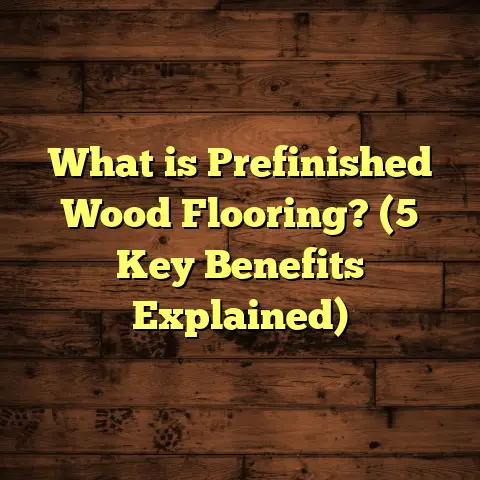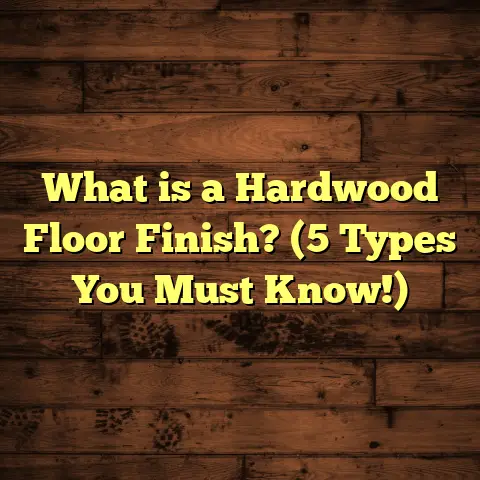What is a Floor Beam? (5 Key Types & Their Uses Revealed)
Embracing Eco-Conscious Choices in Flooring Support
I’ve always had a soft spot for building things that last without causing harm
to the environment. When I first started working with floor beams, I didn’t fully
grasp just how important these components are—not only for structural strength
but also for sustainable building. The way we choose and install floor beams can
have a lasting impact on both the safety of a home and the planet.
Over the years, as eco-consciousness grew in my work and among clients, I began
to see floor beams not just as simple wooden or steel pieces but as vital parts of
a green building strategy. Using engineered wood or responsibly sourced timber,
for instance, can reduce waste and carbon footprint significantly.
If you’re curious about floor beams—what they are, what types exist, and how to
pick the best one for your project—you’re in the right place. I’ll share what I’ve
learned through hands-on projects, research, and a few stumbles along the way.
Plus, I’ll give you data-backed info and practical advice to help you decide wisely.
What Is a Floor Beam?
At its core, a floor beam is a horizontal structural member designed to support
the loads from the floor above. Think of it as one of the main “spines” that hold
up your floor, transferring weight from joists or decking down to load-bearing walls
or foundations.
Floor beams are different from joists, which are smaller and typically spaced evenly
across a floor system. Joists rest on beams, which in turn carry the load over wider
distances. Without properly sized and installed floor beams, floors would sag or even fail.
Here’s a simple way to understand it: if the floor were a bookshelf, joists would be
the shelves holding books, while beams would be the big supports holding those shelves up.
A Bit More on Load Distribution
Floor beams carry dead loads (weight of the floor materials themselves) and live loads
(weight of people, furniture, appliances). The amount of load depends heavily on the building’s
use: residential homes usually need to support around 40-50 pounds per square foot (psf),
while commercial floors might require 100 psf or more.
Choosing the right beam size and material involves calculations based on these loads, span length,
and support conditions. This is where engineering meets practical know-how.
Why Floor Beams Matter: Lessons From My Projects
When I started out, I didn’t pay much attention to floor beams beyond their size and cost. But over time, I realized how much goes into making the right choice.
Early Mistakes and What I Learned
One of my first projects involved replacing floor beams in a 1920s bungalow. The original beams were
solid wood but badly rotted because of poor ventilation in the crawlspace. The joists attached to them
were sagging noticeably. Fixing this meant tearing out old beams and installing new ones while keeping
the house structurally sound.
Here’s what caught me off guard:
- Moisture Control: I underestimated how moisture could degrade wood quickly.
- Load Assessment: The old beams were undersized for modern live loads.
- Material Selection: Simply replacing with similar wood wasn’t enough; I needed something stronger and more durable.
That experience pushed me to dig deeper into modern beam options like engineered wood and steel. It also taught me to check site conditions carefully before recommending materials.
Success Stories That Stand Out
On another job, a client wanted an open-concept living room with minimal posts interrupting the space. Solid wood beams wouldn’t span the width without bulky supports.
I suggested glulam beams—engineered beams made by gluing layers of timber. They were lighter than steel but strong enough to span 20 feet with no posts below. The client loved the clean look and eco-friendly aspect since the beams came from sustainably harvested forests.
This project convinced me of the value of engineered wood: strength, sustainability, and design flexibility all rolled into one.
Floor Beam Material Types: Key Players and What Sets Them Apart
Here’s a detailed look at five common floor beam types I’ve worked with extensively. Each has unique strengths and challenges worth knowing about.
1. Solid Wood Beams
Description: These are traditional beams cut from a single piece of timber. Common woods include pine, oak, Douglas fir, and cedar.
Strengths:
- Natural look; often left exposed for aesthetics.
- Readily available and easy to work with.
- Good for shorter spans or lighter loads.
Challenges:
- Susceptible to warping, splitting, and rot if not properly treated.
- Limited span length compared to engineered alternatives.
- Natural defects like knots can weaken sections.
My Experience: Solid wood beams work well for smaller renovations or additions where budget is tight but appearance matters. However, in damp climates or crawlspaces without proper ventilation, they tend to degrade faster than expected unless sealed or treated.
2. Engineered Wood Beams (Glulam and LVL)
Description: Made by gluing layers of wood together under pressure. Two popular types are:
- Glulam (Glued Laminated Timber): made from multiple layers of dimensioned lumber glued face-to-face.
- LVL (Laminated Veneer Lumber): made from thin wood veneers laminated under heat and pressure.
Strengths:
- Superior strength-to-weight ratio; can span longer distances.
- More uniform and predictable performance than solid wood.
- Uses smaller trees efficiently; better for forests.
- Resistant to warping and twisting.
Challenges:
- Requires proper handling to avoid damage during installation.
- More expensive upfront than solid wood.
- Adhesives require consideration for environmental impact (though many products now use low-VOC glues).
My Experience: Engineered beams have been game-changers for me. On multiple jobs, they allowed wide-open spaces without post supports cluttering rooms. They’re also lighter than steel but still strong enough for heavy residential loads. Clients appreciate their eco-friendly aspect too.
3. Steel Beams
Description: Structural steel beams shaped like an “I” (I-beams) or rectangular tubes.
Strengths:
- Extremely strong; handles heavy loads and long spans.
- Non-combustible—good for fire safety.
- Resistant to rot, pests, and moisture damage.
- Slim profile allows more headroom.
Challenges:
- Requires skilled labor (welding/bolting) for installation.
- Heavier; needs cranes or lifting equipment.
- Conducts heat/cold—may require insulation to prevent condensation.
- Costs vary widely depending on steel market prices.
My Experience: Steel beams are my go-to when strength must come without bulk. Particularly in basements or commercial builds where space is tight but loads heavy. That said, they add complexity to installation schedules because fabrication takes time and precision.
4. Concrete Beams
Description: Reinforced concrete beams made by casting concrete around steel bars (rebar).
Strengths:
- Durable and fire-resistant; lasts decades.
- Excellent load-carrying capacity; ideal for multi-story buildings.
- Low maintenance once installed.
Challenges:
- Heavy; requires cranes for placement.
- Labor-intensive installation; slower build times.
- Rarely used in residential floors due to cost and weight.
My Experience: Concrete beams have their place mostly in commercial or high-rise projects I’ve been involved in. Residential floors rarely call for them because they add weight and cost beyond what’s practical for wooden homes.
5. Composite Beams
Description: Combine materials like steel with timber or concrete with steel to optimize performance.
Strengths:
- Can balance strength and weight perfectly for challenging conditions.
- Tailored solutions for specific architectural needs.
- Often used in industrial or specialized residential projects.
Challenges:
- Complex design requiring structural engineering expertise.
- Higher upfront costs.
- Installation coordination between trades can be complicated.
My Experience: These beams appear occasionally in custom builds where standard materials don’t fit requirements. I’ve had mixed experiences—when designed well they perform beautifully; when specs aren’t precise, issues arise that delay projects.
More on Common Problems With Floor Beams
I want to share some common issues I’ve seen across beam types so you know what red flags to watch out for:
Moisture Damage
Water is the enemy of wood beams—whether solid or engineered. Crawlspaces with poor drainage or basements without vapor barriers cause rot fast. In one job, water seeped into untreated solid wood beams under a house, causing structural failure within five years.
Fixes include improving drainage outside the home, installing vapor barriers under floors, and sealing or treating wood before installation.
Insect Infestation
Termites and carpenter ants love untreated wooden beams. Even pressure-treated lumber isn’t immune if there are cracks or soil contact points nearby.
Metal or concrete beams avoid this problem completely but come with other costs.
Improper Sizing
Sometimes contractors underestimate load requirements or span lengths. That leads to sagging floors or noisy creaking as joists flex too much.
Using engineered beams with precise load calculations prevents this issue better than guesswork alone.
Installation Errors
Incorrect beam placement or inadequate support can cause uneven floors or stress points that lead to cracks or failure later on. When steel beams aren’t properly bolted or supported, safety risks increase dramatically.
I always double-check layout plans against load specs before ordering materials or starting work.
How I Use FloorTally in My Projects
Budgeting flooring projects can get tricky fast—material prices fluctuate daily; labor costs vary by region; waste material adds unexpected expenses.
I started using FloorTally after hearing about it from another contractor friend. This tool lets me plug in local pricing data—like current lumber costs or hourly labor rates—and then calculates realistic total costs including waste factors (which I’d often underestimate).
FloorTally helps me compare scenarios quickly—for example:
- Should I go with solid wood or engineered wood beams?
- How much extra will steel beams add?
- What’s the total labor cost if demolition is needed?
It saves me hours juggling spreadsheets and calling suppliers back and forth. Most importantly, clients appreciate seeing a clear cost breakdown upfront so there are no surprises down the line.
On one recent project replacing old wooden joists with glulam beams, FloorTally showed me that although engineered wood was pricier per linear foot than solid timber, savings on labor (due to easier handling) balanced out costs nicely.
If you’re managing a flooring project yourself—or just want better clarity when talking with contractors—I highly recommend using tools like this alongside professional advice.
Deep Case Study: Restoring a Century-Old Home Floor
One of my most interesting projects involved restoring the floors of an early 1900s farmhouse. The house had beautiful original hardwood flooring but underneath was a mess—the floor beams were undersized 2x8s spaced too far apart with severe rot at several points.
Here’s how I approached it:
Inspection & Assessment
Using moisture meters and visual inspection, I documented every damaged beam section. Load calculations showed the old system couldn’t safely support modern furniture loads (~60 psf).
Choosing Replacement Beams
Given the historic nature, we wanted minimal disruption but maximum strength improvements:
- Decided on glulam beams, which allowed longer spans without adding new posts.
- Selected FSC-certified wood to keep project eco-friendly.
- Added extra ventilation under floors to prevent future moisture buildup.
Installation
We carefully removed sections of old beams without disturbing finished floors above using temporary supports. New glulam beams were craned into place and bolted securely.
Outcome & Client Reaction
The floor no longer sagged or creaked; homeowners loved knowing their century-old house was safer without losing character. Plus, they appreciated the sustainable choices made in beam selection—a big win in my book!
Additional Insights From Industry Data
Beyond my own experience, here’s some research you might find useful:
| Beam Type | Average Span (ft) | Load Capacity (psf) | Typical Cost per Linear Foot (USD) | Environmental Impact Rating* |
|---|---|---|---|---|
| Solid Wood | 10–15 | 40–60 | $10–$20 | Moderate |
| Glulam | 20–40 | 60–100 | $25–$40 | Low |
| Steel | 30–50+ | 100+ | $40–$60 | Moderate |
| Concrete | 20–50+ | 100+ | $50–$70 | High |
| Composite | Varies | Varies | $50+ | Varies |
*Environmental Impact Rating considers resource renewability and carbon footprint related to production.
This table aligns closely with what I see on-site but varies by region and supplier.
Your Questions Answered
You might be wondering:
Q: How do I know which beam is right for my home?
A: Start by figuring out your floor loads (how much weight it needs to carry), span length between supports, budget limits, and environmental conditions (like moisture). Then consult an engineer or experienced contractor who can do precise calculations and recommend materials matching your needs.
Q: Are engineered wood beams really more sustainable?
A: Generally yes—they use smaller trees efficiently and create less waste than solid lumber. Plus, many manufacturers source from certified sustainable forests.
Q: Can I install floor beams myself?
A: Unless you have structural knowledge and tools, it’s risky because improper sizing or placement can cause serious safety problems. Better to hire pros for this part of construction.
Wrapping Up My Take on Floor Beams
From small residential jobs fixing sagging floors to large new-builds needing wide open spaces without posts—floor beams are at the heart of durable flooring systems.
I’ve learned over time that picking the right type means balancing strength requirements, budget constraints, environmental goals, and installation realities. No one-size-fits-all exists here!
Using tools like FloorTally has helped me plan better financially while staying realistic about material needs and labor effort. And sharing real stories—from fixing rotten solid wood beams to installing glulam spans—shows how much care goes into these hidden heroes beneath our feet.
If you’re tackling a flooring project yourself or just want to understand what’s holding your floor up better now—you’re off to a great start just by learning about floor beams this deeply!
Feel free to reach out if you want help choosing materials or planning a project; I’m always happy to chat about floors and what supports them best!
(End of article)





